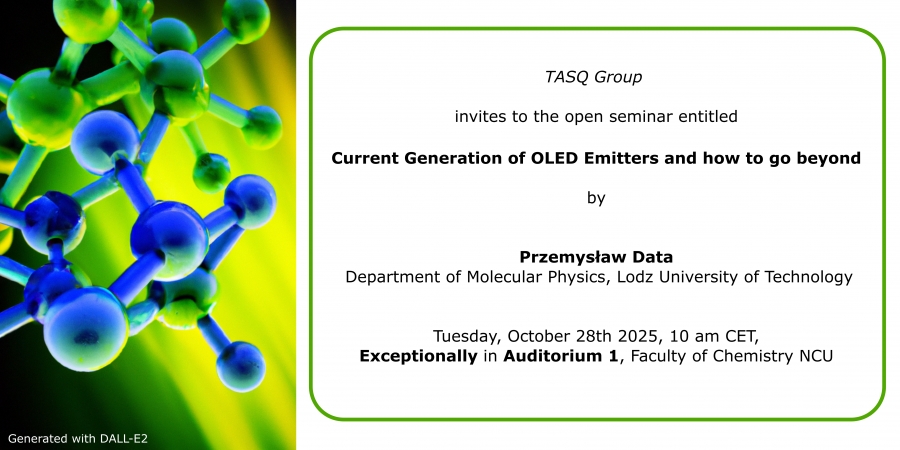
Wykład pt. Current Generation of OLED Emitters and how to go beyond wygłosi prof. dr hab. inż. Przemysław Data z Katedry Fizyki Molekularnej, Wydziału Chemii Politechniki Łódzkiej.
28 października 2025, godz. 10.00 - Audytorium nr 1
Abstrakt
Organic light-emitting diodes (OLEDs) have revolutionized displays, offering superior viewing angles, contrast, and colour compared to traditional LCDs. However, the quest for even better performance continues. This text explores the current state of OLED emitters and exciting possibilities for the future, focusing on third and fourth-generation technologies like TADF, RTP, and hyperfluorescence.
First Generation (Fluorescent) OLEDs utilized fluorescent emitters, limited by a theoretical internal quantum efficiency (IQE) of 25%. The Second Generation (Phosphorescent) emitters offered a significant leap, with a potential IQE of 100% due to their ability to harvest both singlet and triplet excitons (excited states). However, stability issues, particularly for blue emitters, plagued this generation.
Thermally Activated Delayed Fluorescence (TADF) emerged as a game-changer, addressing the limitations of phosphorescence. TADF emitters can theoretically achieve 100% IQE by converting triplet excitons into emissive singlet states through a process called reverse intersystem crossing (rISC). This generation offered Higher efficiency because TADF materials can harvest both singlet and triplet excitons, leading to brighter and more energy-efficient displays. Improved stability compared to phosphorescent emitters, some TADF materials exhibit better stability, particularly for blue emitters. However, designing efficient and stable TADF emitters remains a challenge. Researchers are actively developing new materials with optimized properties.
The quest for even better OLEDs continues with the exploration of fourth-generation emitters like RTP (Room-Temperature Phosphorescence), where materials can achieve long phosphorescence lifetimes at room temperature, potentially leading to displays with lower power consumption and improved colour purity. Hyperfluorescence is when we utilize multiple singlet exciton generation mechanisms within a single molecule, potentially exceeding the 100% IQE limit of traditional emitters. These technologies are still under development, but they hold immense promise for pushing the boundaries of OLED performance.
Here, we would like to present our path in developing efficient, stable, and colour-tuneable TADF, RTP, and hyperfluorescent materials crucial for next-generation OLED displays and lighting.


 ul. Gagarina 7, 87-100 Toruń
ul. Gagarina 7, 87-100 Toruń